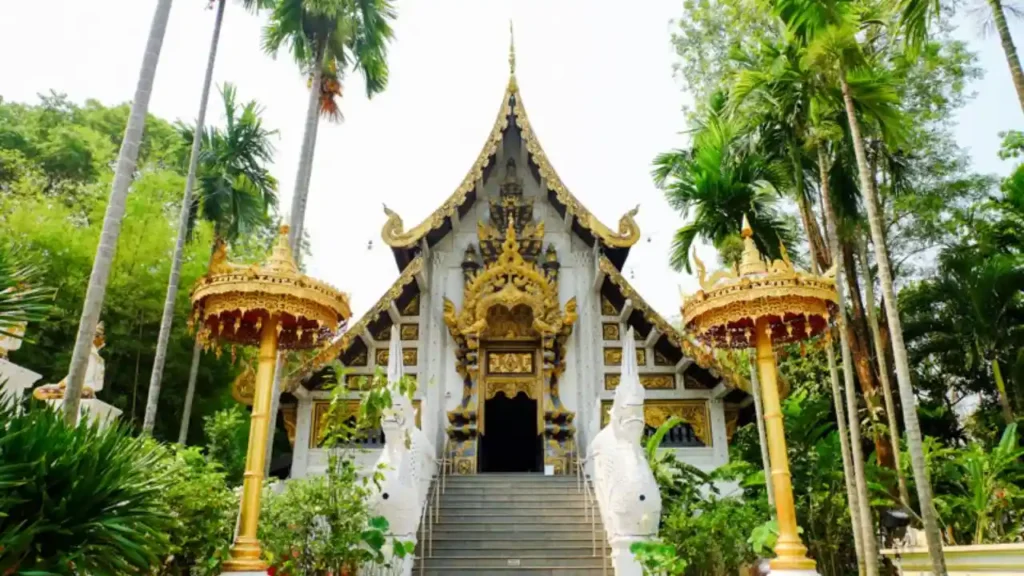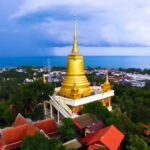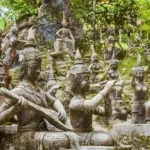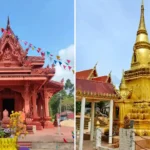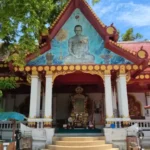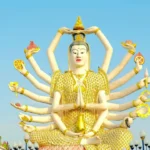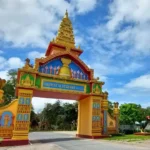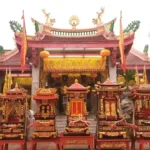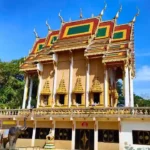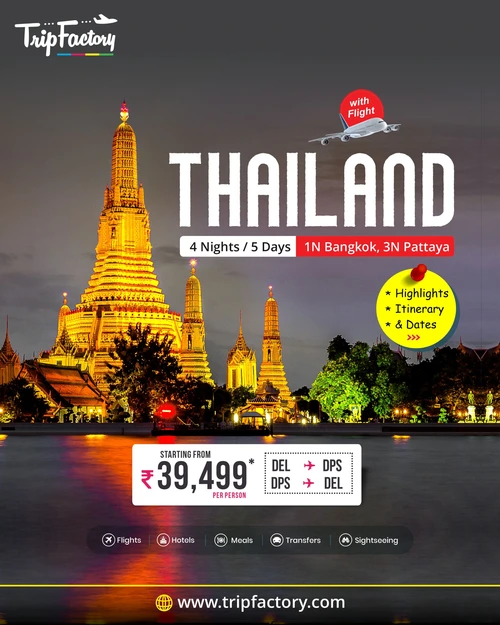The temple is a well-known spiritual and cultural landmark in the area because of its peaceful setting and unique architectural features. The temple complex has beautiful Lanna-style buildings and many important religious statues and artefacts. It has a peaceful atmosphere that is perfect for meditation, reflection, and learning about Thai Buddhist traditions, and it has historical significance.
The chapel called Phra Sayumphu Lokanat has a Sukhothai-style main Buddha image in the position of meditation, which is one of the temple’s most unique features. People who love art and people who worship come to see this peaceful statue because of its fine craftsmanship and symbolic meaning. Many visitors exploring the area through a Thailand tour package also like to visit Chedi Phrabat Si Roi, which has four footprints of a Buddha in the Sukhothai style called Phraputtakarun Kittikhunkhajorn. These footprints are important religious objects that show how Sukhothai influence has been incorporated into northern Thai religious art over time.
History of Wat Pa Dara Phirom
The history of Wat Pa Dara Phirom goes back to when Phra Kru Winaithornman Phurithatto travelled north and settled in an abandoned cemetery near Chao Sabai Garden in Dara Phirom Palace, where Princess Dara Rasami, King Rama V’s wife, lived. Priests and devotees who wanted to do spiritual activities found the peaceful place to be perfect for meditation. Princess Ladakham Na Chiang Mai, the daughter of Princess Dara Rasami, gave part of her mother’s palace land to build the temple in 1941. On December 21, 1938, Wat Pa Dara Phirom was officially registered as a temple. On June 24, 1979, it was given land, and the monastic boundary ceremony was finished on February 9, 1980.
Wat Pa Dara Phirom – Location, Directions & Timings
Wat Pa Dara Phirom is in Chiang Mai province in northern Thailand. It is in a peaceful and beautiful area that is perfect for meditation and spiritual reflection. The temple is easy to get to from the city and is surrounded by lush plants that make the area even more peaceful.
People who are coming from Chiang Mai city can get to the temple by car, motorbike, or local taxi. There are signs pointing to the temple from major roads, and there is parking on-site.
The temple is open every day from 8:00 AM to 5:00 PM. Visitors and devotees are welcome to walk around the temple grounds, meditate, and go to religious services.
Things to Do and See in the Wat Pa Dara Phirom
- The main Buddha statue: In the meditation position is the main focus of the Phra Sayumphu Lokanat Chapel. Visitors can admire the statue’s intricate craftsmanship, watch people pray, and learn more about the statue’s symbolism. Photographers and art lovers often spend a lot of time here taking pictures of the statue’s peaceful beauty.
- Chedi Phrabat Si Roi: It is an important building that has the footprints of four Sukhothai-style Buddhas, called Phraputtakarun Kittikhunkhajorn. People look up to these footprints and think they show the Buddha’s spiritual journey. Visitors have to see the Chedi because of its beautiful architecture and detailed carvings on the outside.
- Phrachao Tanjai Madapa: The Chiang Tung Lanna-style madapa has a Buddha image in the Chiang Saen Sing style, which is a mix of different styles of art from northern Thailand. This building shows how Buddhist art and architecture have changed over time in different parts of the world.
- The Hall of Fame honors Phraphutta Pojanawaraporn: visitors can look at the detailed displays that tell the story of his life, accomplishments, and spiritual impact. This gives them a better idea of how important the temple is to both culture and religion.
- Vihara (Phra Kaew Hall): This is the main place in the temple where people can pay their respects and pray. There are holy pictures in the hall, and it is a great place for religious events and meetings.
- Meditation Hall: A peaceful place for meditation and reflection that gives visitors a break from the busy city. People come here to meditate on a regular basis, and they can learn about mindfulness techniques and traditional Thai Buddhist meditation methods.
- Temple Grounds and Gardens: The temple is surrounded by beautiful gardens that make for a peaceful place to walk. Visitors can walk through beautifully landscaped areas with trees, ponds, and smaller shrines. This place is great for taking pictures, thinking quietly, and enjoying the beauty of nature.
- Cultural and Religious Events: Wat Pa Dara Phirom hosts a number of Buddhist ceremonies, festivals, and celebrations throughout the year. Visitors who take part in these events learn more about Thai culture, spiritual traditions, and the temple-centered community life.
Tips before you visit the Wat Pa Dara Phirom
- You must wear modest clothes. Make sure your knees and shoulders are covered. Don’t wear clothes that show too much skin, and take off your hat when you go into the main halls.
- Early in the morning or late in the afternoon is the best time to take pictures and meditate because the light is better and the place is quieter. To enjoy the temple in peace, stay away from busy tourist times.
- Don’t use flash in halls to show respect for people who are praying.
- Be quiet and respectful at all times in the temple. Don’t touch sacred objects, and do what the temple staff say about how to act and move around the grounds.
FAQs on the Wat Pa Dara Phirom
Usually, there is no charge to get in, but donations are welcome to help keep the temple up and running and support religious activities.
A visit usually lasts between 1.5 and 2 hours, which is enough time to see the main buildings, gardens, and places to meditate.
Yes, guided tours give you a lot of information about the temple’s history, architecture, and religious significance.
Yes, the Meditation Hall has sessions where people can learn traditional Thai Buddhist meditation techniques and practise being present.
Kids are welcome, but visitors should keep an eye on them and make sure they are behaving properly in the peaceful setting.

